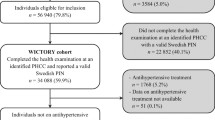ABSTRACT
BACKGROUND
The National Heart, Lung and Blood Institute currently defines a blood pressure under 120/80 as “normal.”
OBJECTIVE
To examine the independent effects of diastolic (DBP) and systolic blood pressure (SBP) on mortality and to estimate the number of Americans affected by accounting for these effects in the definition of “normal.”
DESIGN, PARTICIPANTS AND MEASURES
Data on adults (age 25–75) collected in the early 1970s in the first National Health and Nutrition Examination Survey were linked to vital status data through 1992 (N = 13,792) to model the relationship between blood pressure and mortality rate adjusting for age, sex, race, smoking status, BMI, cholesterol, education and income. To estimate the number of Americans in each blood pressure category, nationally representative data collected in the early 1960s (as a proxy for the underlying distribution of untreated blood pressure) were combined with 2008 population estimates from the US Census.
RESULTS
The mortality rate for individuals over age 50 began to increase in a stepwise fashion with increasing DBP levels of over 90. However, adjusting for SBP made the relationship disappear. For individuals over 50, the mortality rate began to significantly increase at a SBP ≥140 independent of DBP. In individuals ≤50 years of age, the situation was reversed; DBP was the more important predictor of mortality. Using these data to redefine a normal blood pressure as one that does not confer an increased mortality risk would reduce the number of American adults currently labeled as abnormal by about 100 million.
CONCLUSIONS
DBP provides relatively little independent mortality risk information in adults over 50, but is an important predictor of mortality in younger adults. Conversely, SBP is more important in older adults than in younger adults. Accounting for these relationships in the definition of normal would avoid unnecessarily labeling millions of Americans as abnormal.


Similar content being viewed by others
REFERENCES
Veterans Administration Cooperative Study Group on Antihypertensive Agents. Effects of treatment on morbidity in hypertension. Results in patients with diastolic blood pressures averaging 115 through 129 mmHg. JAMA. 1967;202(11):1028–34.
Effects of treatment on morbidity in hypertension. II. Results in patients with diastolic blood pressure averaging 90 through 114 mmHg. JAMA 1970; 213(7):1143–1152.
Neaton JD, Grimm RH Jr, Prineas RJ, Stamler J, Grandits GA, Elmer PJ, Cutler JA, Flack JM, Schoenberger JA, McDonald R. Treatment of mild hypertension study. Final results. Treatment of Mild Hypertension Study Research Group. JAMA. 1993;270(6):713–24.
Prevention of stroke by antihypertensive drug treatment in older persons with isolated systolic hypertension. Final results of the Systolic Hypertension in the Elderly Program (SHEP). SHEP Cooperative Research Group. JAMA 1991; 265(24):3255–3264.
Chobanian AV, Bakris GL, Black HR, Cushman WC, Green LA, Izzo JL Jr, Jones DW, Materson BJ, Oparil S, Wright JT Jr, Roccella EJ. The seventh report of the Joint National Committee on prevention, detection, evaluation, and treatment of high blood pressure: the JNC 7 report. JAMA. 2003;289(19):2560–72.
Bergman AB, Stamm SJ. The morbidity of cardiac nondisease in schoolchildren. N Engl J Med. 1967;276(18):1008–13.
Macdonald LA, Sackett DL, Haynes RB, Taylor DW. Labelling in hypertension: a review of the behavioural and psychological consequences. J Chronic Dis. 1984;37(12):933–42.
Cadman D, Chambers LW, Walter SD, Ferguson R, Johnston N, McNamee J. Evaluation of public health preschool child developmental screening: the process and outcomes of a community program. Am J Public Health. 1987;77(1):45–51.
Feldman W. How serious are the adverse effects of screening? J Gen Intern Med. 1990;5(5 Suppl):S50–S53.
Schwartz LM, Woloshin S. Changing disease definitions: implications for disease prevalence. Analysis of the Third National Health and Nutrition Examination Survey, 1988-1994. Eff Clin Pract. 1999;2(2):76–85.
National Heart, Lung, and Blood Institute (NHLBI) National Institutes of Health. The Eighth Report of the Joint National Committee on Prevention, Detection, Evaluation, and Treatment of High Blood Pressure (JNC 8). Available at: http://www.nhlbi.nih.gov/guidelines/hypertension/jnc8/index.htm. Accessed January 14, 2011.
CDC National Center for Health Statistics' website. Public Use Data Tape Documentation: Medical Examination: National Health and Nutrition Examination Survey, 1971–75. Available at: http://www.cdc.gov/nchs/data/nhanes/nhanesi/4233.pdf. Accessed January 14, 2011.
U.S.Census Bureau. Annual Estimates of the Resident Population by Sex and Five-Year Age Groups for the United States: April 1, 2000 to July 1, 2008. Available at: http://www.census.gov/popest/national/asrh/NC-EST2008-sa.html. Accessed January 14, 2011.
Rutan GH, Kuller LH, Neaton JD, Wentworth DN, McDonald RH, Smith WM. Mortality associated with diastolic hypertension and isolated systolic hypertension among men screened for the Multiple Risk Factor Intervention Trial. Circulation. 1988;77(3):504–14.
Lewington S, Clarke R, Qizilbash N, Peto R, Collins R. Age-specific relevance of usual blood pressure to vascular mortality: a meta-analysis of individual data for one million adults in 61 prospective studies. Lancet. 2002;360(9349):1903–13.
Hulley SB, Walsh JM, Newman TB. Health policy on blood cholesterol. Time to change directions. Circulation. 1992;86(3):1026–9.
Cooper-Dehoff RM, Gong Y, Handberg EM, Bavry AA, Denardo SJ, Bakris GL, Pepine CJ. Tight blood pressure control and cardiovascular outcomes among hypertensive patients with diabetes and coronary artery disease. JAMA. 2010;304(1):61–8.
Gerstein HC, Miller ME, Byington RP, Goff DC Jr, Bigger JT, Buse JB, Cushman WC, Genuth S, Ismail-Beigi F, Grimm RH Jr, Probstfield JL, Simons-Morton DG, Friedewald WT. Effects of intensive glucose lowering in type 2 diabetes. N Engl J Med. 2008;358(24):2545–59.
ACKNOWLEDGEMENTS
This material received no direct funding, but is the result of work supported with resources and the use of facilities at the Minneapolis and White River Junction VA Medical Centers. The views expressed herein do not necessarily represent the views of the Department of Veterans Affairs or the United States Government.
Conflicts of Interest
None disclosed.
Author information
Authors and Affiliations
Corresponding author
Rights and permissions
About this article
Cite this article
Taylor, B.C., Wilt, T.J. & Welch, H.G. Impact of Diastolic and Systolic Blood Pressure on Mortality: Implications for the Definition of “Normal”. J GEN INTERN MED 26, 685–690 (2011). https://doi.org/10.1007/s11606-011-1660-6
Received:
Revised:
Accepted:
Published:
Issue Date:
DOI: https://doi.org/10.1007/s11606-011-1660-6




